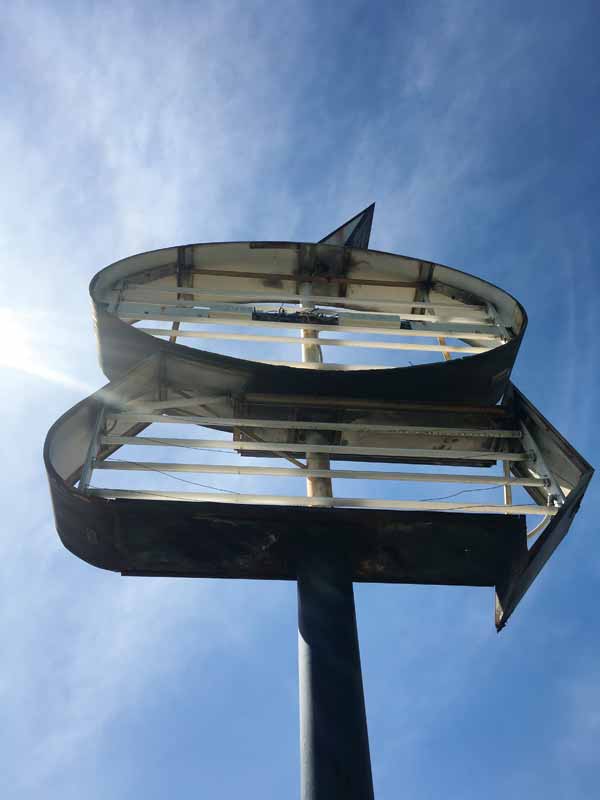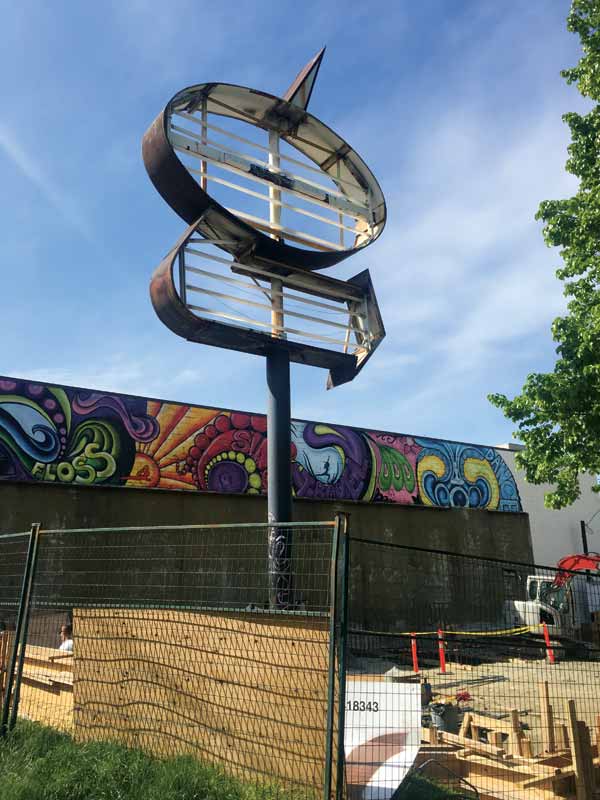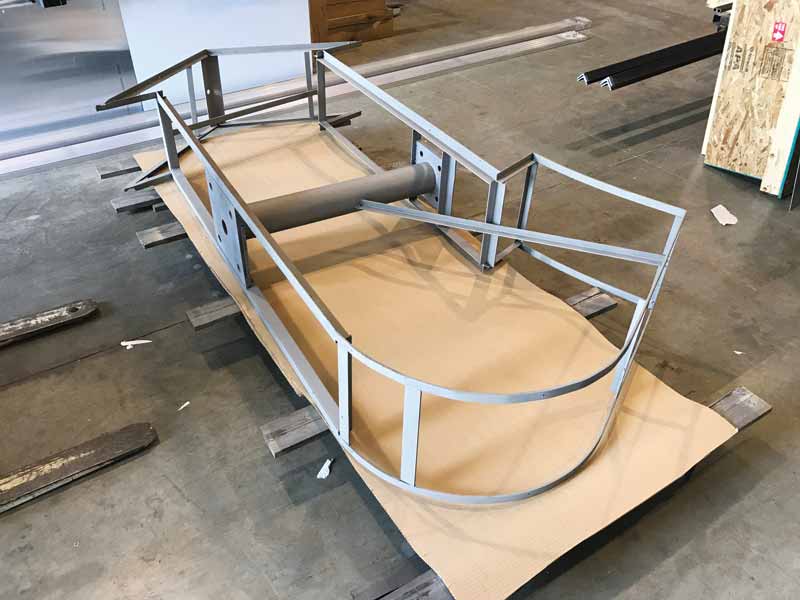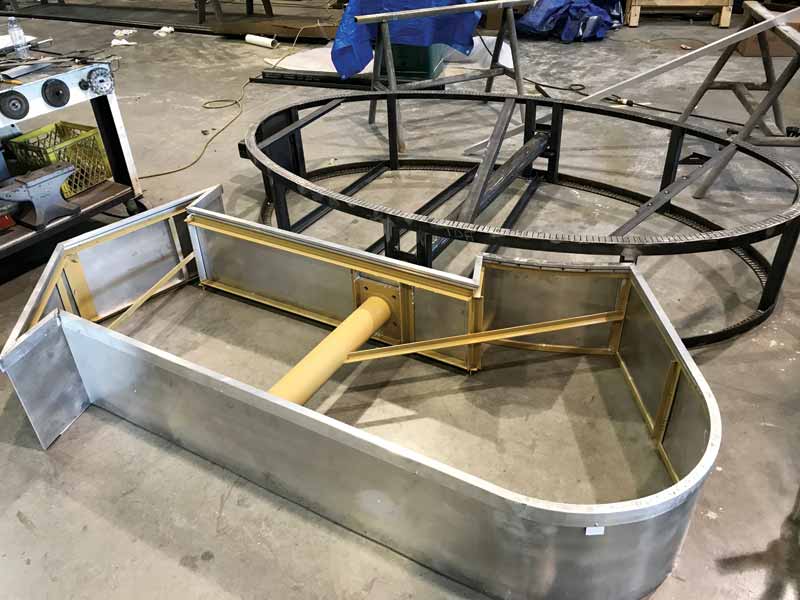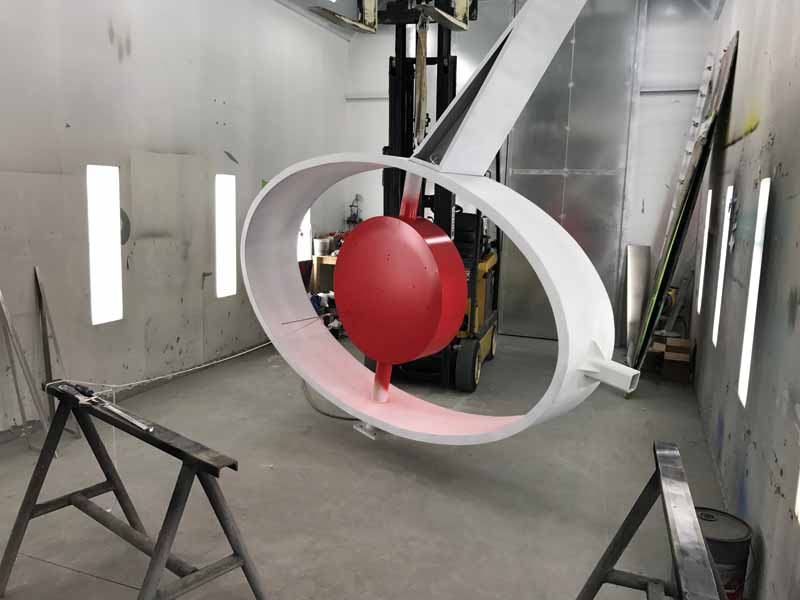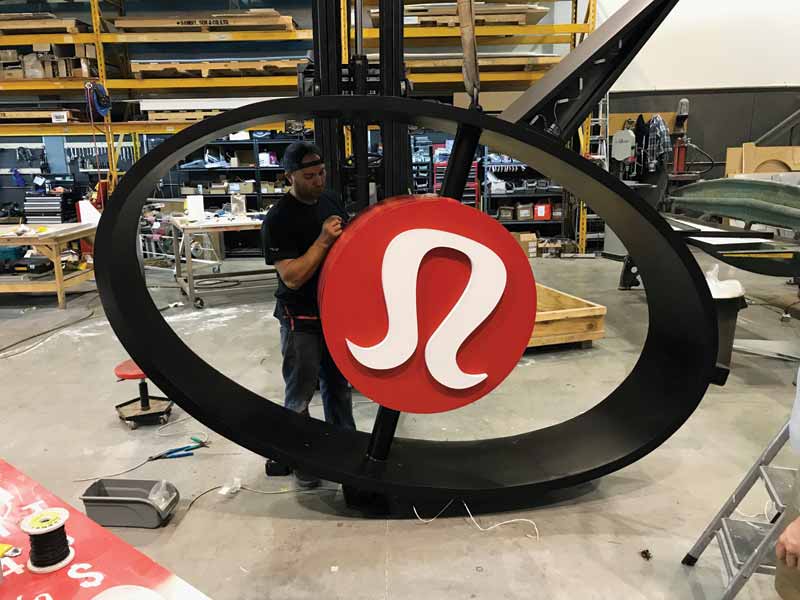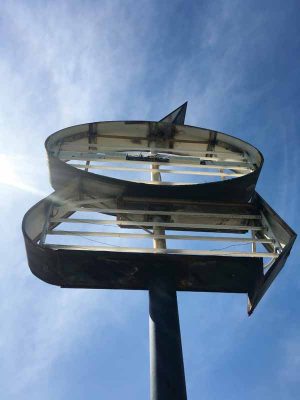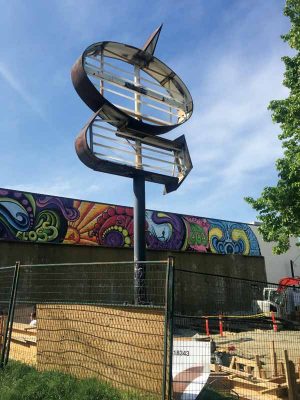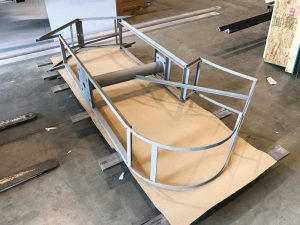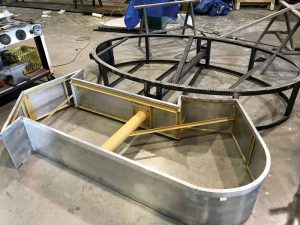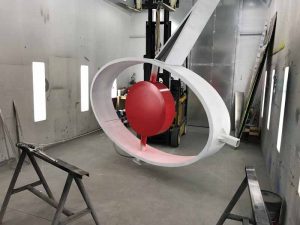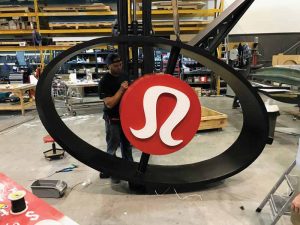Repurposing a 50-year-old sign
by | 8 April 2019 9:10 am
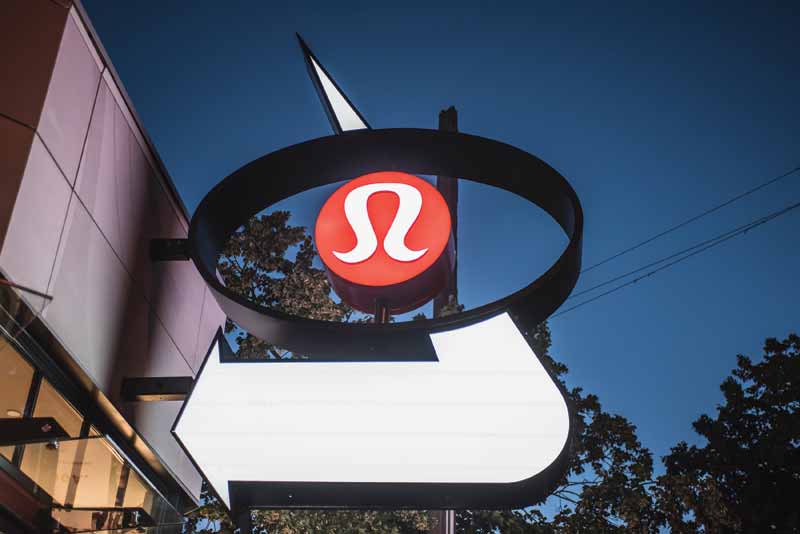 [1]
[1]When planning the build, Lululemon wanted to pay homage to the area surrounding the site, as well as to the long-standing Midas Auto Service Centre itself.
By Troy Hibbs
Founded in Vancouver in 1998, athletic apparel retailer Lululemon has established itself as one of the city’s most recognizable brands, with annual global sales exceeding $2.5 billion. The company’s first store opened near the corner of Arbutus and West 4th Streets and was situated beside a Midas Auto Service Centre.
When the opportunity to purchase the Midas location arose, it was an easy decision for the team at Lululemon to buy the site and expand its original store to add a new women’s section, while the men’s section remained in the original location.
Keeping history alive
When planning the build, Lululemon wanted to pay homage to the area surrounding the site, as well as to the long-standing Midas Auto Service Centre itself.
The company contacted local specialty sign manufacturer TDH Experiential Fabricators to discuss the feasibility of repurposing the store’s existing pylon sign, which had been installed in 1971, into a Lululemon-branded sign, with the goal of keeping enough of the original sign’s shape and structure to ensure it would be recognizable to the local residents. Lululemon had already established a working relationship with TDH through previously completed specialty projects and knew the shop had experience in restorations, replicas, and aged signs.
Upon inspection, it was discovered that the majority of the sign’s structure needed to be reconstructed due to severe rusting and outdated fabrication methods. Further, the installation needed to be re-engineered for stability and strength to satisfy current codes and standards. The sign also needed to be moved slightly to accommodate the store’s renovations, which required a new concrete foundation.
Logistics
The original Midas sign stood more than 6.7 m (22 ft) tall and measured 3 x 2 m (10 x 6.5 ft), with a depth of 0.6 m (2 ft). It was secured to an exposed 0.9- x 0.9-m (3- x 3-ft) concrete foundation, with the larger portion hidden under grade. The sign’s pole, which measured 254 mm (10 in.) in diameter, was bolted to an internal steel cage.
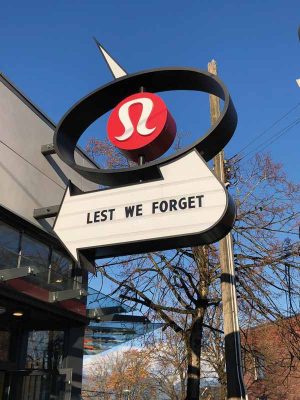 [2]
[2]After purchasing a lot that had been home to a Midas Auto Service Centre, Lululemon decided to repurpose the site’s existing pylon sign.
Due to concern it would be damaged during construction, both the sign and its pole were removed and transported to TDH. After arriving at the shop, the sign was inspected by the fabrication team.
Teamwork makes the dream work
The design process took approximately three months to complete. Working closely with the design team at Lululemon, TDH drafted various concepts, each with its own story and connection to the history of the company, as well as to the neighbourhood. Lululemon was adamant about maintaining its current brand standards, which challenged TDH to find the balance between the old and the new. While the shape of the Midas sign was not particularly complementary to Lululemon’s brand, opening up the centre portion of its main shape created an architecturally interesting detail that pleased all parties.
TDH also had to contend with potential limitations in regards to sign permits within Vancouver. The city’s sign bylaws had undergone multiple revisions since the Midas sign’s original construction in the 1970s, which meant the installation likely did not meet current standards.
Armed with the knowledge that these bylaws are fairly restrictive, TDH brought in its permit consultant, Priority Permits, to help navigate the complexities of the installation—especially since a variance application to the Vancouver council would be necessary to complete the project. With the assistance of Lululemon’s senior management team, TDH and Priority Permits came up with a strategy to satisfy as many of Vancouver’s bylaw requirements as possible, with the hope the remainder could be grandfathered.
 [3]
[3]Lululemon wanted to keep enough of the original sign’s shape and structure to ensure it would be recognizable to local residents.
TDH suggested Lululemon write to the city, detailing the specific situation and outlining the company’s desire to remain true to the site’s original signage. The letter, signed by Lululemon’s vice-president, explained the benefit of preserving the Midas sign in regards to maintaining the neighbourhood’s unique character. The council, respecting Lululemon’s economic contributions to the city of Vancouver, as well as the company’s desire to reflect the past and the present through its restoration, approved the design.
Site construction begins
With the sign permit application submitted to the city, the construction of the new building was well underway; however, some additional challenges regarding the sign’s installation began to surface.
For one, the sign’s existing concrete pad was sitting 0.3 m (12 in.) higher than that of the new building grade, which, as it was positioned near the entrance, posed a significant risk to pedestrians. Second, the existing sign location was incorrectly sited on the architects’ drawings and was much closer to the building’s façade than originally anticipated. These factors necessitated that additional reviews had to
be completed.
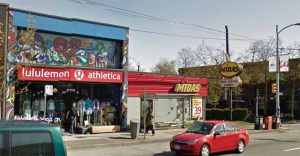 [4]
[4]The original Midas sign was built and installed in 1971.
The teams began by determining if the sign could be moved and affixed to a newly installed concrete foundation; however, this idea was quickly dismissed, as the sign would fall outside the property line.
TDH then considered converting the original pylon design to a projecting sign. While this seemed to be the most logical option, it required the welding of steel support arms to the building’s steel structure, which was nearing completion. To efficiently accomplish this addition, the crew escalated the approval of the sign placement, which allowed enough time for the steel supports to be engineered and installed without affecting the building schedule.
Recreation through fabrication
Once all approvals were in place, TDH’s fabricators began stripping and cutting out the sign’s rusted components. The installation’s old electrical wiring was also removed and its fluorescent tubes and ballasts were replaced with light-emitting diodes (LEDs).
 [5]
[5]Due to complications surrounding the existing concrete pad, TDH opted to convert the original pylon design to a projecting sign.
The majority of the structure was rebuilt with 6.4- x 51-mm (0.25- x 2-in.) welded angle and then sheeted to provide a clean finish. Extra attention was taken in securing the ‘yogo’—the brand’s signature logo shape—to the sign’s vertical pole, as this aspect needed to be as discreet, but also strong enough to support the top of the sign.
Transport was also a consideration, as the installation’s size made this process very costly and difficult to achieve with the sign in one piece. Thus, the lower ‘arrow’ portion was built separately with an internal attachment plate to secure it to the upper ‘oval’ portion. This allowed the sign to be transported from the shop to the site on one truck bed. The two pieces were then hoisted by crane and assembled on-site before being lifted into place.
The engineered attachment design allowed the sign’s steel tube arms to slip inside the steel structural tubes that had been welded to the building’s steel structure. The tolerance, however, was only 6.4 mm (0.25 in.), which meant the welding to the building steel needed to be accurate, as did the tube placement on the two sections of the sign.
As the sign was comprised of two separate pieces, it was necessary to determine precisely how these sections would fit together prior to installation. As such, TDH completed three site inspections to ensure the tube arms of the sign they were fabricating aligned with those fixed on the building.
A seamless installation
To complete the installation, TDH partnered with fellow Vancouver-based sign shop Tops Lighting, which provided the large equipment required for the job, as well as qualified personnel with many years of experience.
 [6]
[6]The sign’s old electrical wiring was removed and its fluorescent tubes were replaced with light-emitting diodes (LEDs).
As the site was located at a very busy intersection, TDH hired a local traffic control company to block the sidewalks and street, which allowed the crane and bucket trucks to get into proper position. Nonetheless, the on-site assembly and installation was challenging; the glass awning situated below the sign only allowed for a few inches of clearance when the sign was hoisted into place—any deviation or even a gust of wind could have caused it to swing and hit the glass.
Fortunately, through a tedious hoist and much-needed guidance by two crews in bucket trucks, the sign was successfully slipped into the tubes with no damage to the glass. The bolts were put in place, the power was hooked up, and final touch-ups were added.
After 14 months of designs, securing permits, and fabrication, Lululemon’s repurposed sign, reflective of the old and the new, was successfully installed.
Troy Hibbs is the founder of TDH Experiential Fabricators, a specialty sign manufacturer located in Vancouver. For more information, visit www.tdhsigns.com[7].
- [Image]: https://www.signmedia.ca/wp-content/uploads/2019/04/Lululemon-0003.jpg
- [Image]: https://www.signmedia.ca/wp-content/uploads/2019/04/IMG_0275.jpg
- [Image]: https://www.signmedia.ca/wp-content/uploads/2019/04/Lululemon-0011.jpg
- [Image]: https://www.signmedia.ca/wp-content/uploads/2019/04/Screen-Shot-2018-07-26-at-2.14.29-PM.jpg
- [Image]: https://www.signmedia.ca/wp-content/uploads/2019/04/Screen-Shot-2017-06-30-at-5.16.05-PM.jpg
- [Image]: https://www.signmedia.ca/wp-content/uploads/2019/04/Lululemon-0031.jpg
- www.tdhsigns.com: https://tdhsigns.com/
Source URL: https://www.signmedia.ca/repurposing-a-50-year-old-sign/
